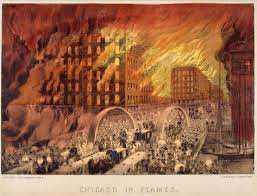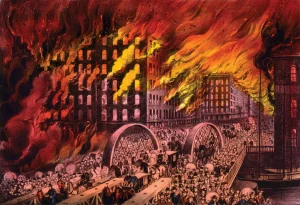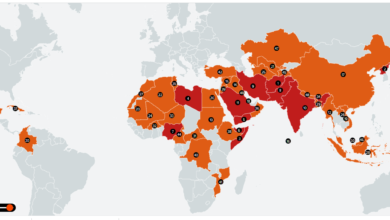EconomyPolitical EconomyWorld/America
Chicago rebuilt after being blazed to the ground by fire-
A can-do spirit, devotion to community and free-market capitalism

January 29-
“The most famous fire in American history happened in Chicago on October 8, 1871. But it’s not the fire that is so remarkable. It’s what happened afterwards. To understand why, we first need to know something about the city’s history.
In 1840, Chicago was a small town of forty-five hundred souls. It ranked 92nd in population in the United States. Yet, only three decades later, by 1870–just a year before the great fire–Chicago was closing in on a population of 300,000, making it the fifth-biggest city in America and the fastest-growing city in the world. 

What led to all this rapid growth? In three words: location, location, location.
“Chicago was near the center of the country, and near where the waterways and railways met,” city historian Tim Samuelson notes. “It was a perfect place for anything and anyone to get anywhere…”
Timing had a lot to do with it, too. America was moving from a rural to an industrial power. Chicago was right in the middle of the action. Ironically, its rapid growth was almost its undoing. “[Chicago] had to build, and build quickly, and so they built it out of wood,” explained Sarah Marcus of the Chicago History Museum. “It was quick, it was easy, and it was cheap.”
And, as it turned out, very flammable.
By most accounts, the fire started on the city’s West Side, near the De Koven Street barn of Patrick and Catherine O’Leary. No one is sure of the cause, but it could have been anything, from vandals to a drunken neighbor to that clumsy cow of urban legend.
Within minutes, the blaze roared out of control, tearing through Chicago’s business district. The fire was so hot, it created its own tornado of flame. By 3:30 a.m., all hope of saving large parts of the city was gone. Nearly 30 hours later, the fire finally died. The reason? There was nothing left to burn.
The losses were staggering: The fire claimed nearly 300 lives, destroyed over 17,000 buildings covering almost 3.5 square miles, and caused damage of over $200 million-about 3.8 billion today. Roughly a third of the city lay in ruins, and one out every three people living in Chicago–nearly 100,000 residents–became homeless overnight.
“All the law offices were destroyed, all the major hotels were destroyed, all the major department stores were destroyed, and all the major banks were destroyed,” Chicago weather historian Tom Skilling notes.
In those days, there were no national or state agencies to help. Chicago was on its own.
What was to be done? To most of Chicago’s citizens, the answer was obvious: Rebuild. Make the city better than ever. Yes, there were many victims of the fire, but there was no sense of victimhood. Even before the bricks stopped smoking, the people of Chicago went to work.
First, the damage had to be assessed. The death and destruction were obvious. But there were some major pluses as well. The stockyards and meat packing plants had been spared. Two-thirds of the grain elevators survived. And most importantly, the railway and rail stock escaped major damage. This was critical because it would allow shipments of building materials and private relief aid to come pouring in from across the country and around the world.
The banking community quickly rallied. Within 48 hours, 12 of the 29 banks that had burned to the ground were operating in makeshift facilities. Merchants–large and small–immediately set up temporary shops. Local financier Henry Greenbaum sent letters to investment bankers all over the globe. This wasn’t the time to give up on the city; it was the time, he told them, to buy in. Many agreed. 

Among them were creative young architects attracted to the nearly blank slate the city presented to them. They would raise a new city from a new product: steel. Their work, praised and copied all over the world, came to be known as the Chicago School.
By 1890, only 20 years after the fire, Chicago’s population passed the one-million mark, becoming the second-biggest city in America. The population had more than tripled since the Windy City’s darkest night.
Why is this all important to know? Because the government didn’t rebuild Chicago. Chicago rebuilt Chicago. And with astonishing speed and energy. A can-do spirit, devotion to community and free-market capitalism made it happen. It’s impossible to look at this achievement without admiration–and more than a bit of nostalgia.
Could we summon that same spirit today?
Yes. We can. But only if we proudly retell stories like this one that remind us the greatness of America is not a product of government, but a product of self-government–empowered citizens pursuing their own best interests.
I’m , host of “Our American Stories,” for Prager University.”
Courtesy: PragerU

